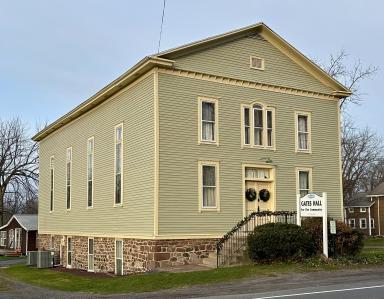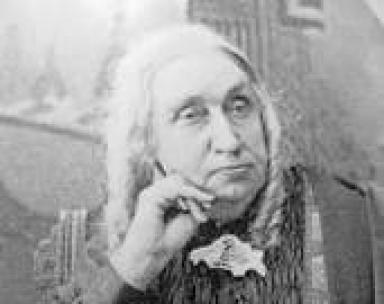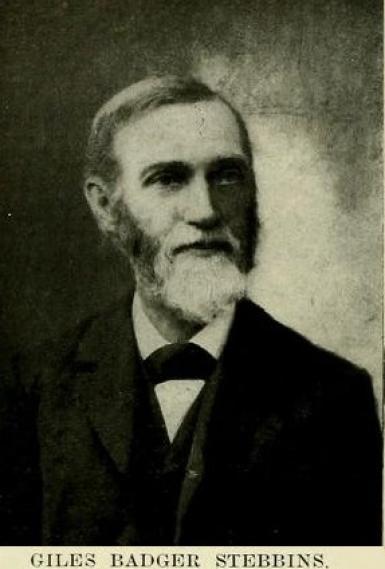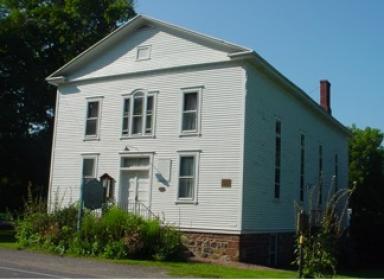Gates Hall
(originally the Union Church) is today the oldest, continuously
active small community theatre in the United States. It was
originally built as a sacred place of worship, a community meeting
place, and lecture hall, and it became a community theatre and
entertainment venue 1867.
On December 27,
1825, a group of early settlers gathered to frame a church
constitution that would serve as the foundation of first the
religious, and then the cultural growth in the area for the next
almost 200 years. Originally known as the “Union Church,” this
landmark structure became the first non-denominational sacred place
of worship for the hamlet of Pultneyville and surrounding
communities. It was used primarily by two main bodies—the
Methodists and Presbyterians—and later a third body known as
Spiritualists.
Erecting the
building was a community effort led by Andrew and Ansel Cornwall,
prominent early landowners in the hamlet. With cash being scarce,
most citizens paid with goods and labor, including lumber and grain,
one barrel of cider, boots and shoes, cut stone, one barrel of prime
pork, and 3,000 feet of hemlock boards that still form the
eye-catching ceiling. When Union Church was completed, a balance of
$3.06 was left in the treasury, reflecting the careful budgeting of
our early settlers.
The
cornerstone of the Union Church was laid by members of the
Pultneyville Masonic Lodge #201 which today is #159 whose Lodge is
just 4 doors west of Gates Hall. Together, the community did
it—they built a church!
Two decades later,
community came together again to celebrate the 20th
Anniversary of the building, working on needed repairs and the
installation of additional pews. The church
eventually split into two churches, and the last church service in
Gates Hall was held in 1875.
Notable Speakers
Through the Years
Gates Hall didn’t
originally have a stage as it does today, but it had galleries on
each side and in the back of the building. It has hosted many
lectures and meetings by local residents and others from afar on
social, moral and religious issues of the day and the evils of
alcohol and slavery. Some of the topics addressed by notable speakers
include:
Spiritualism
Government
& Affairs of the Nation
1863 - Giles B.
Stebbins of Rochester on “Hatyou Government” and antislavery
1864 - E. W.
Cooper, Editor of the West Branch Bulletin published in
Williamsport, PA
1864 – Lewis
H. Clark, late principal of the Sodus academy and his private,
select school in Pultneyville, “James River and its Historic
Association.”
Significance: Site of lectures by abolitionists such as Frederick Douglass, Lucy Colman, and Giles B. Stebbins
Discussion: Frederick Douglas spoke at Gates Halls in 1849, 1853 and 1861. In October 1861, on Sunday afternoon at 2:00 o’clock, Frederick Douglass and Giles B. Stebbins both spoke in Union Church. The subject was “The Present Crisis, Its Cause and Remedy.“ "Let the House be full to overflowing at both places. The truth will do you good,” noted the Commercial Press. Stebbins spoke again the church on Friday evening, April 21, 1865, on the subject of “The Death of President Lincoln, Its Lesson of Duty and Danger to Us.“
Summation of Frederick Douglass and Giles B. Stebbins October Speech at Gates Hall:
WAR LECTURES - Frederick Douglas and G.B. Stebbins, of Rochester, spoke to the inhabitants of this village on Sunday, Oct. 13, on the cause and remedy of the present war, showing it clearly as all know it to be, attributed solely to the existence of slavery in our country; going back to the commencement, and at the time the two ships landed on our continent, one at Plymouth and the other at James River, Virginia, and tracing it along down until the present time. The remedy is to petition Congress, at its next session, praying for the emancipation of slavery throughout the Union - confiscating whatever property may be found in the hands of the rebels, and recompensing all those that are found true and loyal to the Union. The administration, as well as the people, will find out very soon that the policy which Fremont has marked out on our western borders will be the only true course to adopt.
On November 28, 1865, Pultneyville citizens gathered for a service to dedicate the new 15-foot marble monument to Union soldiers. S.C. Cuyler had been the prime mover in raising the money. Local abolitionists James Gregg (who served as a chaplain in the Civil War) and Lewis H. Clark, former Underground Railroad activist and later superintendent of the Sodus Academy, spoke. The obelisk is located in the Lakeview Cemetery, Lake Road, Pultneyville and bears the inscription of fourteen names of soldiers from Williamson who lost their lives in the Civil War. It is important to note that it was the first such monument to be erected in New York State and is believed to be the first in the United States.
Temperance
– while talked about . . . not always practiced in Pultneyville!
Phrenology
Abolition
Perhaps the most notable of all to lecture at Union Church, now Gates
Hall, was Frederick Douglass, influential abolitionist, on the topic
of Slavery. His interest as a former slave himself, was to strengthen
the Anti-Slavery Movement. He visited Pultneyville on three
documented occasions in 1849, 1853, and 1861.
The Civil War: Union Church/Gates
Hall also played a role in the Civil War when . . .
“The
women of Pultneyville united in a body without organizing a society,
worked Worked this way – a responsible woman would call on a few
other women and the magic word would go around that forthwith a box
or a barrel must be sent to our brave soldiers. It was sure to be
done! A goodly number of barrels were sent filled with white cotton
shirts, drawers, stockings, carpet slippers, bundles of soft linen
and cotton cloth rolls and rolls of bandages, dried fruit, honey, and
many other things. At first barrels were packed in private homes, but
later on, it was decided it would be more convenient to use this hall
where things could be spread out. It was about this same time that a
wish expressed by Dr. A. F. Sheldon, surgeon in the hospital at
Washington, DC to give the invalid soldiers a Thanksgiving dinner.
Three local women started out and walked two miles each way, and in
less than a week they had turkeys, chickens, fried cakes, lies,
cheese, fruit, etc. enough to feed them all they wanted. It was
packed and on its way to Washington where it arrived in good
condition and on to time! This same Dr. Sheldon who attended
President Lincoln, lived in Pultneyville and maintained a practice
here before, and after, the Civil War.”
Theatrical
Performances Begin
In June 1867, a new
organization was founded within Union Church, and the first adult
group began stage entertainments and charged admission. In order to
create a stage for the exhibitions and entertainments in the Hall,
planks were laid across the pews and pulpit, and a pole was stretched
across the side wings to suspend a large stage curtain. This was the
beginning of adult theatre groups from Pultneyville, and other
traveling groups of players, performing at the Hall—a tradition
that proudly continues today!
The Renaming to
Gates Hall
In 1892, with
increasing community use of the Hall, the building was silently
decaying, and the steeple bell had ceased to ring and was beginning
to lean. Union Hall Trustees recognized that the building needed
extensive work to make it over into a public building, so the local
citizenry attended a meeting with a view toward creating a “Village
Hall,” and a public solicitation was immediately undertaken.
In February 1893,
those who had pledged their money, volunteered their time or donated
materials, met to establish an organization to oversee the work. It
was at that time that Miss Mary Gates of Sodus, NY, pledged $1,000
toward the building fund; however, there was a stipulation attached
to her gift—The building must be raised and a basement
constructed beneath! It was done . . . shoring up the building
for future generations.
At a special meeting
on April 18, 1894, the Hall was dedicated and by raising a vote, a
resolution was unanimously accepted to recognize the outstanding
contributor by naming the new Village Hall in her honor— GATES
HALL. Now devoid of the creaking steeple and rickety side galleries,
Gates Hall sported a strong new foundation and basement, the
sheathing, its hemlock ceiling, a new floor, and for the first time
in the history of the Hall, in the 18-foot northern extension, a
permanent stage. No more planks across the pews!
Gates Hall
Performance Groups through the Years
Since its humble
beginnings, many church, community and civic groups have concurrently
used Gates Hall for dramatic presentations, plays, musicals, dance
recitals, minstrel shows, exhibitions, educational forums, a variety
of benefit fundraising performances. and more.
In 1867, the first
play group was known as the “Pultneyville Lyceum,” which was the
same name adopted by an earlier school debating society. Proceeds
from the evening went towards improvement of the walks in the
hamlet—a need, along with many others, that continues to exist
today!
Other groups and
activities through the years include, but are not limited to:
District #1
School (cobblestone across the street)
The
Pultneyville Lyceum
The Koetsville
(Cootsville) School
Pultneyville
Dramatics Club (PDC)
The
Pultneyville Glee Club
The
Pultneyville Select School
Pultneyville
Reformed Church
Pultneyville
Methodist Church
Pultneyville
Fire Company
The Girls
Entertainment Club
American Relief
Fund Variety Shows
Memorial Day
exercises
Pultneyville
Players (PP) – started in 1947 at which time it was stipulated
that the group must pay for coal, water, the janitor, fire and
liability insurance, and obtain specific approval from the
Association for each use. This very popular group was made-up of
local actress and actors.
Pultneyville
Civic Light Opera Company which was dedicated to the production of
Gilbert & Sullivan operettas
And most recently
. . .
Youth Theatre
The Gatesinger,
Co. Ltd. who have been Artists in Residence
The Sandy
Stramonine Dance Company
The
Williamson-Pultneyville Historical Society Play Group
Pultneyville
Home and Historic Site Tour
Local Writers
Reading Group
Pultneyville
Holiday Illumination
The Williamson
Central School District
The Lake
Ontario Proposed Marine Sanctuary Advisory Council
The Wayne
County Bicentennial Committee
The ROC City
Ringers
“A Christmas
Carol” . . . a one man, two act play
The C. A.
Palmer Fife and Drum Corps
Raise A Glass
Foundation Premium Wine Fundraiser
Garage Sale and
Craft Beer Fundraiser
I ❤️
NY Path Through History Tour Site
Gates Hall Today
Today, almost, 200
years later, the Williamson-Pultneyville Historical Society
(W-PHS)—an all-volunteer 501(c)3—is the owner and sole steward of
Gates Hall, and the community continues to come together to sustain
the maintenance and make improvements to the building as needed to
preserve its structural and architectural integrity.
In 2006, a plan was
formulated to stabilize the building using a ‘bottom-up and
top-down’ approach—from the bottom-up with $100,000 worth of work
done in the basement and during COVID in 2021, another $125,000 was
spent for the top-down to further stabilize the building,
concentrating on much needed structural remediation between the
ceiling and the roof and a full roof replacement.
Gates
Hall resides on the State and National Registers of Historic Places.
Originally,
35 structures in Pultneyville were placed on the State and National
Registers in 1985, and Gates Hall and the Pultneyville Public Square
(Centennial Park) were added in 2000 as a separate structure outside
the historic Pultneyville district, but still in the historic hamlet.
While there were originally 35 structures, several have since been
lost through the years to fire or general decline due to neglect and
lack of preservation.
Gates
Hall remains
to this day, the only large public building of its kind in this
rural, agricultural region hosting cultural
and theatrical events.
In
addition to its continual use as a theatre, the building is
multi-functional as a lecture hall, community meeting place, and a
venue for a variety of community events sponsored by the W-PHS and
other community groups. We
are so pleased that with the support of community and friends, Gates
Hall has, and continues to keep its prominent place in history.


.jpg)


